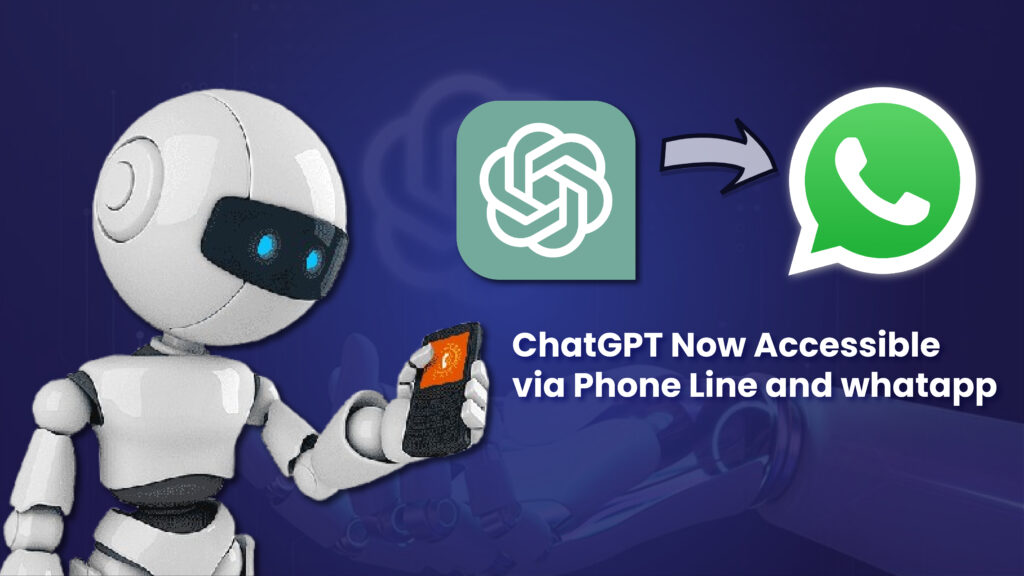ChatGPT Now Accessible via Phone Line and WhatsApp: Expanding Global Access
In a groundbreaking move to expand the accessibility of artificial intelligence, OpenAI has introduced two major features that make ChatGPT more available than ever. The first is a phone line service for users in the United States, allowing them to interact with ChatGPT without the need for cellular data or an internet connection. The second is a global integration with WhatsApp, enabling users around the world to access ChatGPT through Meta’s popular messaging platform. These innovations aim to bridge the digital divide and bring advanced AI technology to areas with limited or no internet access.
ChatGPT via Phone Line: Bridging the Connectivity Gap:
OpenAI has launched a dedicated phone number, 1-800-CHATGPT (1-800-242-8478), that allows users in the U.S. to call and speak directly with ChatGPT. This new feature leverages traditional voice networks, meaning users can access the AI without needing internet connectivity, making it a game-changer for people in areas with poor or no internet access.
By using Advanced Voice Mode technology, ChatGPT can now engage in natural, fluid conversations over the phone. The service allows users to ask questions, receive information, or engage in casual discussions just as they would through the web interface, but all without relying on an internet connection. This feature is especially beneficial for people in remote areas, travelers, or anyone who may experience network disruptions but still needs access to an AI-powered assistant.
OpenAI demonstrated the phone service during a live stream on YouTube, showcasing how it works. For example, users on a road trip can now call the number to get information about landmarks or other things they encounter along the way—without having to upload images or videos. This makes ChatGPT more practical and useful in everyday scenarios, especially for those who are frequently on the move or living in regions where connectivity is a challenge.
ChatGPT on WhatsApp: Expanding Access Worldwide
Alongside the phone line service in the U.S., OpenAI is also expanding ChatGPT’s reach globally by integrating the AI chatbot with WhatsApp. Now, users worldwide can chat with ChatGPT directly through the popular messaging app. This integration allows users from various countries to access the chatbot without needing a dedicated app or web browser, simply by starting a conversation with 1-800-242-8478.
WhatsApp is one of the most widely used communication platforms globally, making it an ideal choice for expanding ChatGPT’s availability. By integrating with WhatsApp, OpenAI can reach a broader audience in regions where the app is widely adopted. This feature also eliminates the need for users to download additional apps or rely on internet browsers, making it easier for anyone with WhatsApp to start using ChatGPT.
Future Plans: Enhanced Account Integration:
Looking ahead, OpenAI has announced that it is working on enabling users to log into their ChatGPT accounts via the WhatsApp bot. This would allow users to access their personalized ChatGPT experience through the app, just as they would on the web or through a mobile app. Such an integration will ensure that users can maintain continuity across platforms, preserving their settings, past conversations, and preferences, while providing a seamless experience regardless of the device or platform used.
This upcoming feature is expected to enhance the user experience, allowing people to have more tailored interactions with ChatGPT. Users who have specific preferences or need to refer back to previous chats will be able to do so directly from WhatsApp, without any extra steps or hassle.
Enhancing Accessibility for All:
The main goal behind these updates is to make ChatGPT more accessible to people who may not have reliable access to the internet. By offering the chatbot via traditional phone lines and WhatsApp, OpenAI is ensuring that AI technology is not limited to those with stable internet connections. This move is particularly important for individuals in rural or underserved areas where internet connectivity is often unreliable or unavailable.
By utilizing voice networks and the ubiquitous WhatsApp platform, OpenAI is bridging the gap between advanced technology and everyday communication tools. This approach makes it easier for more people to engage with AI-driven information and assistance, helping to overcome the digital divide that affects many regions worldwide.
The Future of AI Accessibility:
These new features represent a significant step forward in making advanced AI technology more inclusive and universally accessible. OpenAI is continuing to innovate and enhance its offerings to ensure that people from all walks of life can benefit from ChatGPT, regardless of where they live or their level of internet access.
The integration with WhatsApp also demonstrates OpenAI’s commitment to meeting users where they are, with a platform that is already widely used around the world. The phone line service in the U.S. offers an alternative that is invaluable for those without internet access, proving that AI can be integrated into traditional communication networks.
As OpenAI continues to refine these features, the future looks bright for the continued expansion of AI accessibility. Whether through a phone call in remote areas or a WhatsApp chat anywhere in the world, ChatGPT is becoming a more inclusive and widely available tool for anyone who needs it.
Conclusion:
OpenAI’s new features—ChatGPT via phone line and WhatsApp integration—mark a milestone in making AI technology accessible to a wider audience. These updates offer convenient, reliable access to ChatGPT, whether users are at home, on the road, or in regions with limited connectivity. By expanding the ways people can interact with the AI, OpenAI is ensuring that its powerful technology is available to anyone, anywhere, at any time. As these features evolve and expand, it’s clear that AI is becoming more integrated into our daily lives, offering assistance, information, and conversation without the barriers of internet connectivity.


